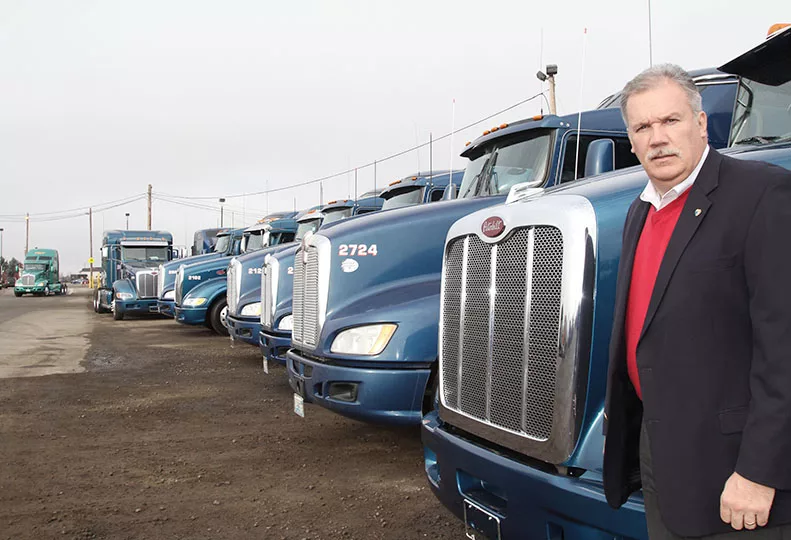
Home » Truck driver shortage raises pressure
Truck driver shortage raises pressure
Long-haul trucking companies having trouble filling positions

November 7, 2013
A shortage of qualified truck drivers both here and across the U.S. is causing some companies to step up recruiting practices and refocus their attention on regional hauls.
Mark Barnes, co-owner of Spokane-based Fast Way Freight Inc., says companies that send drivers on regional or local hauls can have better luck hiring and retaining drivers; however, regional companies are experiencing some shortage as well.
"We're in a segment that's a little easier, but we've seen it slow down," Barnes says. "We've definitely felt it tighten up."
Regional and local drivers, he says, have the advantage of being home every night, whereas long-haul drivers might be gone for two or three weeks at a time.
Jeff Benesch, vice president of personnel for Cheney-based Trans-System Inc. says, "The long haul schedule is so irregular, it makes it tough. But it's a pivotal part of the trucking industry."
Trans-System, which operates System Transport Inc., TWT Refrigeration Service, and James J. Williams Bulk Transport, has outlets around the country and runs both long and regional hauls, Benesch says.
Spokane Valley-based Inland Empire Distribution Systems Inc., which only drives within a 150-mile radius of its locations in Spokane and Pasco, Wash., also has had an easier time retaining drivers. However, company President and CEO Jim Ewers says it's feeling the effects of the shortage as well.
"Overall we're seeing a tightening in driver supply even at the local level," Ewers says.
As a company, Benesch says, Trans-System has to take a look at the shortage and come up with a plan to meet its growth goals.
"We spend a significant amount of money on advertising to attract drivers, both experienced and new," he says.
Benesch says the company uses different media to recruit drivers, including newspaper ads and social media. Social media, he says, is the company's No. 1 source for recruiting.
Barnes says Fast Way runs ads to recruit drivers as well, but also relies heavily on word-of-mouth. Because it offers drivers a more regular schedule, the company has slightly more success recruiting, he says.
"We do have an easier time recruiting, but that may change. We think it's going to get harder," Barnes says.
IEDS is also stepping up recruiting practices to attract drivers, say Ewers and company human resources coordinator Tary Lambert.
"We're casting our net further and longer to get qualified applicants," says Ewers. "We're advertising longer in different publications. We also keep our market wage and benefits up to date."
Lambert says the company also has experienced a shift in taking recruiting practices online, something she says many companies in the industry are doing.
To become a qualified driver in the state of Washington, Benesch says, the state Department of Licensing has mandated that an applicant must complete 160 hours of training prior to taking the Class A Commercial Driver's License test. The training consists of behind-the-wheel training, backing up, proficiency development, and classroom work, he says.
Benesch also says that the state DOL will recognize the prior experience of military veterans who might come into training having already driven big trucks while in the service.
"They can bypass some of the requirements and apply their military experience to taking the CDL," he says.
A variety of factors are contributing to the shortage, say Benesch and Barnes. Barnes says that younger people aren't as interested in being career drivers, and Benesch says that a large number of experienced drivers are now nearing retirement age.
Another problem, Benesch says, is the federal program known as Compliance Safety Accountability, which tracks and directly monitors individual drivers, not just the trucking companies. If a driver has any problems or infractions, it goes on that person's CSA record permanently.
He also says that Trans-System has seen a 3 to 5 percent drop in productivity due to new federal regulations limiting the number of service hours a driver can log between rest breaks or without days off.
"Long-haul drivers get paid by the mile," Benesch says. "When you have productivity loss, it equates to drivers' paychecks."
At Trans-System, Benesch says, a driver fresh out of training will make somewhere between $34,000 and $43,000 annually, depending on what division they're in. An experienced driver, he says, typically will earn between $50,000 and $60,000, and could earn as much as $90,000 as solo drivers in certain situations.
Barnes also attributes the shortage to economic improvements, saying that when the economy is better, drivers have more job options close to home.
"When the economy starts improving and construction and housing start to grow, you see the driver pool drop because these guys can stay home and make money doing a construction job, and not have to be gone all the time," he says.
The time away from home, Benesch says, is the toughest obstacle to overcome when trying to recruit long-haul drivers.
"In several segments, drivers aren't afforded a 9-to-5, Monday-through-Friday schedule," he says. "We try to compensate them for being gone."
To combat the shortage, Trans-System is attempting to regionalize more of its fleet, Benesch says, by focusing on loyal area customers.
"By going into niche markets and working with dedicated customers, we're getting our drivers home faster," he says.
Benesch also says that Trans-System expects to add another 40 trucks to its fleet in the next year. The challenge, he says, will be attracting enough drivers to operate them.
"Not only are we purchasing those assets, but we need to find drivers to fill those seats," he says. "The long-haul truck driver is a dying breed."
Trans-System, Benesch says, employs certain strategies to retain its drivers. He says that corporately, the company has an annual driver-turnover rate of about 35 percent. Benesch says he believes the industry average turnover rate to be around 80 percent. Trans-System retains its drivers by focusing on recognition, communication, implementing new technology, compensation, and training drivers through its school, Driver Training and Solutions.
Trans-System processes anywhere from 800 to 1,000 driver applications a month, he says. Of those, he says, only one of every 15 applicants is qualified to be hired. When hiring drivers, the company looks at the applicant's driving record, certifications, CSA scores, and job history, he says.
In 2012, he says, the company had 854 drivers; currently it has about 900. While that's an increase in overall drivers, it's not enough to keep up with the rising demand, Benesch says.
"When we look at growth, we're adding those 40 new trucks next year, and I have a very limited stream of applicants to fill them," he says.
Ewers says that IEDS has been able to keep up with demand; the company ran 16 trucks last year, and is running 20 this year. However, he says, it's planning to add more capacity.
The American Trucking Association has said that to keep up with demand, an average of 96,000 drivers need to be hired nationally every year. If demand continues to increase, that number could grow to as many as 240,000 drivers annually by the 2022, the association says.
For the trucking industry as a whole, Benesch says, the consequences of the driver shortage could result in longer shipping time, and rising wages.
"It lowers our ability to meet demand. There's more freight out there than trucks to haul it," he says.
Barnes says, "It's supply and demand. You'll see freight rates go up and costs will go up."
Barnes also says the shortage could result in delays in deliveries.
"There's a ripple effect to it," he says. "If you're a manufacturer and you can't ship as expeditiously, there's delays, it could shut down production and/or deliveries to your customer."
Latest News
Related Articles


_web.webp?t=1764835652)
